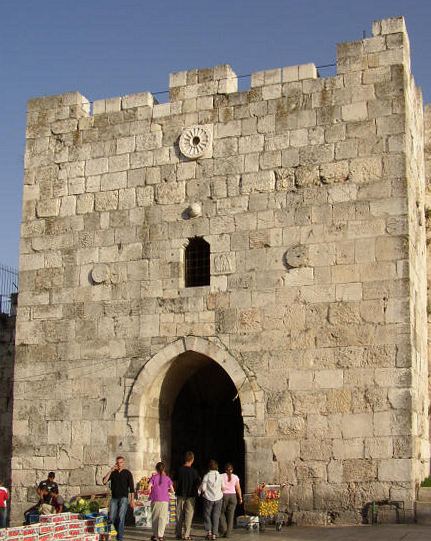Town or city Jerusalem | Phone +972 2-627-1422 | |
 | ||
Address Sultan Suleiman St, Jerusalem Hours Open today · Open 24 hoursFridayOpen 24 hoursSaturdayOpen 24 hoursSundayOpen 24 hoursMondayOpen 24 hoursTuesdayOpen 24 hoursWednesdayOpen 24 hoursThursdayOpen 24 hours Similar Lions' Gate, Damascus Gate, New Gate, Zion Gate, Jaffa Gate | ||
Herod's Gate (Hebrew: שער הפרחים Sha'ar HaPrakhim Flowers Gate, Arabic: باب الزاهرة, Bab az-Zahra) is a gate in the northern walls of the Old City of Jerusalem. It adjoins the Muslim Quarter, and is a short distance to the east of the Damascus Gate. Its elevation is 755 meters above sea level.
Contents
Herod s gate stabbing 3 zaka via media resource group
Names
Herod's Gate is the Christian name of the gate. In Luke 23:7 Jesus is sent by Pontius Pilate to Herod Antipas, and a Christian tradition identifies the site of nearby Greek Orthodox Church of St Nicodemus with the palace of Herod Antipas. The current church is built on top of a ruined Crusader church and is called in Arabic Deir al-'Adas, "the monastery of the lentils", based on another tradition claiming that it once had a soup kitchen feeding lentil soup to the poor. Yet another tradition claims that the church is built on top of the prison in which Saint Peter was held by Herod Agrippa, the nephew of Herod Antipas.
Bab az-Zahra is the Arab Muslim name of the gate. In proximity to the gate is an Arab neighborhood called Bab az-Zahra. Az-Zahra is a corruption of the name As-Sahira given to the hill and cemetery across the road, where people are buried who have performed the pilgrimage to Mecca. Sura 79; 6-14 of the Koran speaks of the Day of Resurrection using the phrase "they shall return to the earth's surface ("as-sāhira")", and an old tradition interprets this term as the proper name of a concrete valley or plain, identified at least since the 11th century as the nearby Kidron Valley. The other meaning of "sahira", taken as a verb, is "to be watchful" and would indicate how the newly resurrected would look around waiting for the events to follow. The name "Sahira", once corrupted to "Zahra", sometimes rendered as "Zahara" and on maps from the late 19th-early 20th century as "Zahira(h)", became very similar to an Arabic word for flower or blossom, zahra.
Sha'ar HaPrakhim, "Flowers Gate", is the Hebrew name of the gate. Interpreted as a translation of the Arabic Bab az-Zahra, explained above, it would seem to be a misnomer. However, the popular etymology of the Hebrew name connects it to the stone rosette which decorates the gate tower.
History
This modest gate, which opens from a wall tower, is one of the newest gates of Jerusalem. At the time when Suleiman the Magnificent built the city walls in the 1530s, a small wicket gate was situated in the eastern, lateral wall of the tower, which was rarely opened. Formerly, the sprawling residential area within this gate was known as Bezetha (effectually translated as "New City"), settled during the late Second Temple period to accommodate Jerusalem's growing population. By 1875, in order to provide a passageway to the new neighborhoods which were beginning to develop north of the Old City, the Ottomans opened a new gate in the northern, frontal wall of the tower, which faces the Sultan Suleiman Street and offers easier access, and closed the original lateral gate.
In 1998 and during several subsequent excavation seasons (the latest in 2004), archaeologists of the Israel Antiquities Authority dug in the eastern area of Herod's Gate. The digging focused on three separate areas adjacent to the wall, in which nine archaeological layers were discovered – covering from the Iron Age up through the Ottoman period. Among the most significant discoveries were structures from the period of the Second Temple, a complete segment of the Byzantine-Roman wall, and remnants of massive construction underneath the wall. These remnants were identified as portions of a fortification from the ancient Muslim period and from the Middle Ages. These discoveries point out the importance which the rulers of the city gave to the fortification of one of its most sensitive places—the northern wall of Jerusalem. Indeed, historical accounts indicate that in 1099 the Crusader army under Godfrey of Bouillon entered the city through a breach located slightly east of the present Herod's Gate.
